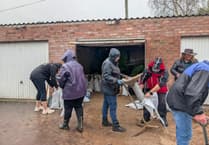STAND (Severnside Together against Nuclear Development) held a public meeting in Lydney on October 17th to look at the prospect of Small Modular (nuclear) Reactors (SMRs) being built at Oldbury.
There were four speakers including two from STAND, Sue Haverly and John French. who have been sharing information about the two nuclear installations at Oldbury and Berkeley since the 1980s and monitoring safety since the two stations were decommissioned. The other peakers were former Friends of the Earth director Sir Jonathan Porritt and renewable energy expert Dr David Toke.
Sue Haverly initially referred to all the work done by a small group of local people who formed SCAR (Severnside Campaign against Radiation) when a cluster of six childhood leukaemia cases were discovered in close proximity to Lydney in the mid 1980s. The group took steps to challenge the lack of monitoring of the effects of low-level radiation and started to campaign against any further expansion of nuclear sites on the River Severn. When the prospect of a large nuclear power station to be sited at Oldbury was proposed in 2009, STAND was formed and the group pointed to a government report from 2005 which declared that there was a serious risk of flooding at Oldbury due to climate change and that any development should be moved further inland.
John French spoke of why nuclear power expansion would be ‘disastrous’ for the UK because of ‘the prohibitive cost that would see higher electricity bills for everyone and take money away from developing renewable energy and storage.’ The record of nuclear development in this country reveals many ‘expensive delays that mean nuclear power can never come in on time to combat climate change’ and then there are the problems of ‘vulnerability to cyber and terrorist attacks’ , ‘the risk of a serious accident requiring the evacuation of millions of people’ and ‘the intractable problem of the disposing of highly dangerous nuclear waste’
David Toke spoke of the fact that wind power is now producing more electricity than nuclear globally and in the UK, and that solar was gaining ground even faster. The prospect of the rolling out of SMRs was portrayed as something to ‘con the public there is something new’ with. He also added that locals around Oldbury would have to be prepared for probably a decade of lorry travel disruption.
Jonathan Porritt spoke of the main challenges faced – ‘low carbon, energy security and affordability’ and pointed to complete unlikelihood that any of these would be solved by a renaissance of nuclear power.
Stephen Bray , Regional Communications and Stakeholder Manager of Great British Energy–Nuclear, has said of the Oldbury site: "The site remains under the ownership of GBE-N, and we’ll continue to work on it to prepare it for future projects... For example, we’ll be constructing a site compound, and subject to planning consent from the local authority, we’ll be starting the ground investigation works in the new year. It’s probably important to say that the intention has always been for there to be a fleet of SMRs built across multiple sites, and it’s possible that a project for further SMRs project or any other advanced nuclear energy technology could come forward for Oldbury.”





Comments
This article has no comments yet. Be the first to leave a comment.